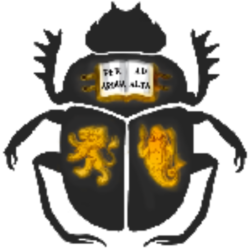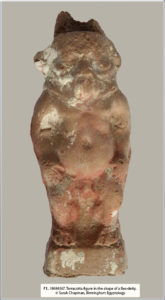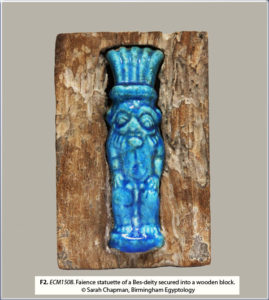Click the images to enlarge
——————————————————————————————————————————————————————————-
F. Object Labels (pdf file)
Click here for a 3D pdf model of F2. ECM1508 (pdf file)
Depictions of the Bes-image continue into the Greco-Roman Period and it is possible that during this period the name ‘Bes’ became a general term for the confusing multitude of similar deities explored above in this exhibition (Dasen 1993: 57). The protective purpose  of ‘Bes’ is maintained throughout this period through the adornment of the god in military equipment, often depicted as a Roman solider in terracotta. The Bes-image is also transferred onto household objects at this time such as lamps as can be seen in 1969A567. The image presented in this object is clearly of a human dwarf form and appears to have relinquished many of the leonine features seen throughout the imagery of preceding periods. These leonine features are not however missing in ECM1508, a faience statuette that is preserved in an original wooden block. Spurr et al. theorised that the presence of the wooden block indicates an original architectural placement for the object and suggested a possible domestic context, a ‘birthing room’ or a temple setting such as the ‘Bes Chambers’ found at Saqqara or the Bes oracle found at Abydos (Spurr et al. 1999: 61). Many of the features of ECM1508 reflect the accumulation of iconographic traits for the Bes-image of the previous two millennia, such as the squatting pose with bow legs, human limbs, with a beard/mane around the face, leonine ears, tongue sticking out and large plumed headdress. Whilst it is the final Bes-image for discussion in this analysis of their iconographic development, it seems a fitting example to finish with due to its amalgamation of these various forms.
of ‘Bes’ is maintained throughout this period through the adornment of the god in military equipment, often depicted as a Roman solider in terracotta. The Bes-image is also transferred onto household objects at this time such as lamps as can be seen in 1969A567. The image presented in this object is clearly of a human dwarf form and appears to have relinquished many of the leonine features seen throughout the imagery of preceding periods. These leonine features are not however missing in ECM1508, a faience statuette that is preserved in an original wooden block. Spurr et al. theorised that the presence of the wooden block indicates an original architectural placement for the object and suggested a possible domestic context, a ‘birthing room’ or a temple setting such as the ‘Bes Chambers’ found at Saqqara or the Bes oracle found at Abydos (Spurr et al. 1999: 61). Many of the features of ECM1508 reflect the accumulation of iconographic traits for the Bes-image of the previous two millennia, such as the squatting pose with bow legs, human limbs, with a beard/mane around the face, leonine ears, tongue sticking out and large plumed headdress. Whilst it is the final Bes-image for discussion in this analysis of their iconographic development, it seems a fitting example to finish with due to its amalgamation of these various forms.



